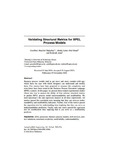| dc.contributor.author | Muketha, Geoffrey M. | |
| dc.contributor.author | Ghani, A. A. A. | |
| dc.contributor.author | Atan, R. | |
| dc.date.accessioned | 2020-11-21T19:28:44Z | |
| dc.date.available | 2020-11-21T19:28:44Z | |
| dc.date.issued | 2020-10-28 | |
| dc.identifier.citation | Journal of Web Engineering, Vol 19 Iss 5-6 | en_US |
| dc.identifier.uri | https://journals.riverpublishers.com/index.php/JWE/article/view/5733 | |
| dc.identifier.uri | http://hdl.handle.net/123456789/4458 | |
| dc.identifier.uri | https://doi.org/10.13052/jwe1540-9589.19566 | |
| dc.description.abstract | Business process models tend to get more and more complex with age, which hurts the ease with which designers can understand and modify them. Few metrics have been proposed to measure this complexity, and even fewer have been tested in the Business Process Execution Language (BPEL) context. In this paper, we present three related experimental studies whose aim was to analyse the ability of four selected structural metrics to predict BPEL process model understandability and modifiability. We used Spearman’s rho and regression analysis in all three experiments. All metrics passed the correlation tests meaning that they can serve as understandability and modifiability indicators. Further, four of the metrics passed the regression test for understanding time implying that they can serve as understandability predictors. Finally, only one metric passed the regression test for modification time implying that it can serve as a modifiability predictor. | en_US |
| dc.language.iso | en | en_US |
| dc.publisher | River Publishers | en_US |
| dc.subject | BPEL processes | en_US |
| dc.subject | business process models | en_US |
| dc.subject | web services | en_US |
| dc.subject | metrics validation | en_US |
| dc.subject | structural complexity | en_US |
| dc.subject | modifiability | en_US |
| dc.subject | understandability | en_US |
| dc.title | Validating Structural Metrics for BPEL Process Models | en_US |
| dc.type | Article | en_US |

